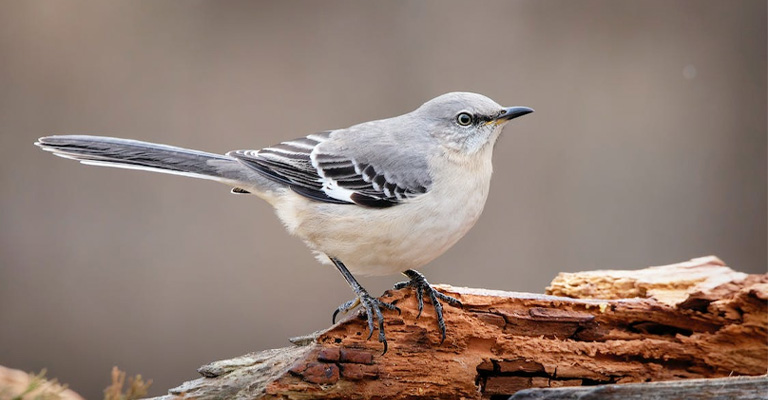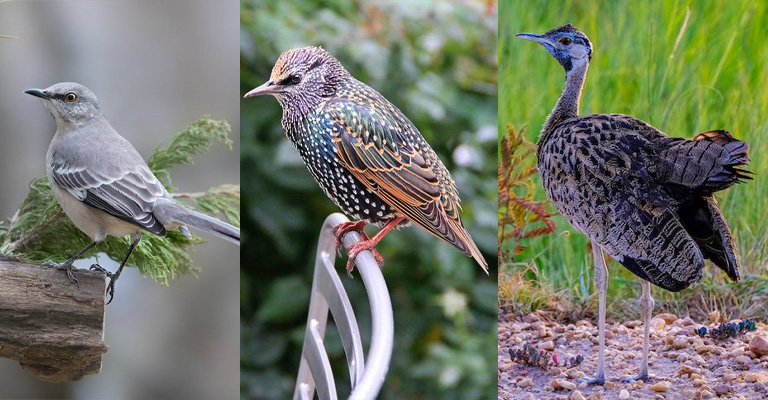Mockingbirds, known for their remarkable ability to imitate the songs and calls of other birds, have long captivated the curiosity of bird enthusiasts and researchers alike.
These talented avian performers, scientifically known as mimids, possess a unique vocal repertoire that sets them apart from other species.
But what drives mockingbirds to mimic the sounds of their feathered counterparts? Is it simply a display of their vocal prowess, or does it serve a deeper purpose? In this article, we delve into why do mockingbirds mimic other birds.
From attracting mates to defending territories, mockingbirds employ their vocal mimicry skills in a variety of ways, showcasing their adaptability and intelligence. Join us as we unravel the secrets behind the captivating mimicry of these charismatic songsters.

Why Do Mockingbirds Mimic Other Birds?
Mockingbirds, scientifically known as mimids, possess a unique ability to imitate the songs and calls of various bird species. This behavior has intrigued researchers and bird enthusiasts for years. Here are eight detailed reasons behind the mimicry behavior of mockingbirds:
Attracting Mates
Male mockingbirds use their mimicry skills to impress potential mates. By showcasing a diverse repertoire of songs, they demonstrate their genetic fitness and ability to provide for offspring.
Defending Territories
Mockingbirds use mimicry as a territorial defense strategy. By imitating the calls of other birds, they create the illusion of a larger group, deterring intruders and protecting their nesting sites.
Establishing Social Hierarchy
Within mockingbird communities, vocal mimicry plays a role in establishing social hierarchies. Dominant individuals may mimic the songs of subordinate birds to assert their dominance and maintain their status.
Learning and Development
Young mockingbirds learn to sing by imitating the songs of other birds. Through mimicry, they acquire a diverse repertoire of vocalizations, which helps them communicate and establish their own unique song.
Environmental Adaptability
Mockingbirds inhabit a wide range of habitats, and their mimicry skills allow them to adapt to different environments. By imitating local bird species, they blend in and communicate effectively with their surroundings.
Vocal Practice
Mimicking other birds’ songs provides mockingbirds with an opportunity to practice and refine their vocal abilities. This helps them develop their own unique song and improve their overall vocal performance.
Food Acquisition
Some mockingbirds mimic the distress calls of other bird species to attract insects or small prey. This behavior, known as “aggressive mimicry,” lures unsuspecting prey closer, making it easier for the mockingbird to capture its meal.
Vocal Communication
Mockingbirds use mimicry as a form of communication with other bird species. By imitating the calls of neighboring birds, they establish social bonds, exchange information about food sources or predators, and coordinate group activities.
Through their diverse repertoire of imitated songs and calls, mockingbirds navigate the complex social dynamics of their communities, attract mates, defend territories, and communicate effectively with other bird species.
The fascinating mimicry abilities of mockingbirds continue to captivate researchers and bird enthusiasts, shedding light on the intricate world of avian communication and adaptation.
Can Mockingbirds Mimic Humans?

Yes, mockingbirds have been known to mimic various sounds, including human vocalizations. While their primary repertoire consists of imitating the songs and calls of other bird species, mockingbirds have the ability to mimic a wide range of sounds they encounter in their environment, including human speech and other non-bird sounds.
Mockingbirds are highly skilled vocal mimics, and their ability to imitate human sounds can be quite impressive. They can mimic words, phrases, and even specific tones or accents.
However, it’s important to note that not all mockingbirds will mimic human sounds, and the extent of their mimicry can vary among individuals.
The reasons behind mockingbirds mimicking human sounds are not fully understood. It is believed that they learn these sounds through exposure to their surroundings, including human voices in urban or suburban areas.
Some researchers suggest that mockingbirds may mimic human sounds as a form of vocal practice or as a means of expanding their vocal repertoire.
While it is possible for mockingbirds to mimic human sounds, it is not a common occurrence and may vary among individuals and populations.
How Do Mockingbirds Mimic?

Mockingbirds have a remarkable ability to mimic a wide range of sounds, including the songs and calls of other bird species. Here’s an overview of how mockingbirds mimic:
Auditory Learning
Mockingbirds begin their mimicry journey as nestlings. During this time, they listen to the songs and calls of their parents and other birds in their environment.
They have a unique ability to learn and memorize these sounds, forming the foundation for their mimicry skills.
Vocal Repertoire
Mockingbirds have a specialized vocal organ called the syrinx, located at the base of their trachea. This complex structure allows them to produce a wide variety of sounds.
By manipulating the muscles and airflow through the syrinx, mockingbirds can mimic the pitch, rhythm, and tone of other bird species’ vocalizations.
Imitation and Practice
Young mockingbirds start imitating the sounds they hear around them, including the songs and calls of other birds. They experiment with different sounds and gradually refine their mimicry skills through practice. They may imitate the sounds of their parents, siblings, or neighboring birds.
Repetition and Variation
Mockingbirds learn through repetition. They practice imitating specific sounds repeatedly, gradually incorporating them into their vocal repertoire.
They also add their own variations and improvisations to the imitated sounds, creating unique renditions of the original vocalizations.
Environmental Exposure
Mockingbirds are highly adaptable and can mimic a wide range of sounds they encounter in their environment.
This includes not only the songs and calls of other bird species but also non-bird sounds such as sirens, car alarms, or even human speech. They learn these sounds through exposure and incorporate them into their mimicry repertoire.
Contextual Mimicry
Mockingbirds not only mimic the sounds of other birds but also the context in which those sounds occur.
For example, they may imitate the alarm calls of a particular bird species when they perceive a potential threat or mimic the songs of neighboring birds to establish social bonds or communicate territorial boundaries.
Individual Variation
Each mockingbird has its own unique vocal repertoire and style of mimicry. While they share some common imitations, such as popular bird songs in their habitat, they also develop their own variations and preferences based on their exposure and learning experiences.
Mockingbirds’ mimicry abilities are a result of their exceptional auditory learning, vocal flexibility, and practice. Their mimicry skills allow them to communicate, attract mates, defend territories, and adapt to their environment.
The diverse and impressive mimicry of mockingbirds continues to fascinate researchers and bird enthusiasts, highlighting the complexity and adaptability of avian vocalizations.
Can Different Bird Species Mimic Each Other?

Yes, it is possible for different bird species to mimic each other. While mockingbirds are well-known for their mimicry abilities, they are not the only bird species capable of imitating the sounds of other birds.
There are several examples of different bird species mimicking each other’s vocalizations. Here are a few instances:
European Starlings
European starlings are highly skilled mimics and can imitate the songs and calls of various bird species. They often incorporate the sounds of other birds into their own vocal repertoire, including species like the Northern Flicker, Red-tailed Hawk, and Meadowlark.
Lyrebirds
Lyrebirds, native to Australia, are renowned for their exceptional mimicry skills. They can imitate not only the songs of other bird species but also a wide range of sounds from their environment, including human speech, car alarms, and even camera shutters.
Superb Fairywrens
Male Superb Fairy-wrens have been observed mimicking the alarm calls of other bird species as a deceptive tactic.
By imitating the alarm calls of potential predators, they create confusion among other birds, diverting their attention away from their own activities.
Marsh Warblers
Marsh Warblers are known for their ability to mimic the songs of other bird species, often incorporating them into their own complex and melodious songs.
They can imitate a wide range of species, including warblers, thrushes, and even non-bird sounds like frogs or insects.
These examples demonstrate that mimicry is not limited to a single bird species. Different bird species can mimic each other’s vocalizations as part of their communication repertoire.
Mimicry can serve various purposes, including attracting mates, defending territories, and establishing social hierarchies.
It is a fascinating aspect of avian behavior that highlights the adaptability and complexity of bird vocalizations.
FAQs
Birds mimic the vocalizations of other species for various reasons. It can serve as a form of communication, allowing them to interact with other birds and establish social bonds. Mimicry can also be a way to attract mates, defend territories, or confuse predators.
Birds learn to mimic other species’ sounds through a process called vocal learning. They listen to and imitate the vocalizations they hear in their environment, including the songs and calls of other bird species.
Mimicking other species’ vocalizations can provide birds with several benefits. It can help them blend in with their surroundings, making it easier to communicate and interact with other birds.
While some bird species, such as parrots and mynas, are well-known for their ability to mimic human speech, it is less common for other bird species to do so.
However, there have been instances of birds, like the Hill Myna and the European Starling having the ability to mimic human speech.
Yes, birds can mimic a wide range of sounds other than vocalizations. Some species, like the lyrebird, are known for their ability to mimic environmental sounds such as car alarms, chainsaws, or even musical instruments.
Bottom Line
The mimicry abilities of mockingbirds are a testament to the incredible diversity and adaptability of the avian world.
Their talent for imitating the songs and calls of other birds serves multiple purposes, from attracting mates and defending territories to communicating and establishing social hierarchies.
By mimicking the sounds of other species, mockingbirds demonstrate their versatility and intelligence, showcasing their ability to adapt to different environments and situations.
As we continue to study and appreciate these remarkable birds, their mimicry behavior provides us with a deeper understanding of the complex dynamics of avian communication and the fascinating strategies employed by different species.
So, the next time you hear the melodious and ever-changing song of a mockingbird, take a moment to appreciate the incredible mimicry skills that make them one of nature’s most captivating performers.